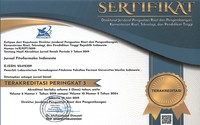Aktivitas Antiinflamasi Ekstrak Etanolik Daun Arbenan [Duchesnea indica (Jacks.) Focke]
Abstract
Keywords
Full Text:
PDF (Bahasa Indonesia)References
Amarowicz, R. (2007) ‘Tannins: the new natural antioxidants?’, European Journal of Lipid Science and Technology, 109(6), pp. 549–551. doi: 10.1002/ejlt.200700145.
Apridamayanti, P., Sanera, F. and Robiyanto, R. (2018) ‘Aktivitas Antiinflamasi Ekstrak Etanol Daun Karas (Aquilaria malaccensis Lamk.)’, Pharmaceutical Sciences and Research, 5(3), pp. 152–158.
Dalimarta, S. (2004) Atlas Tumbuhan Obat Indonesia. 3rd edn. Jakarta: Puspaswara.
Ergina, Nuryanti, S. and puspitasari, I. D. (2014) ‘Qualitative test of Secondary Metabolistes Compounds in palado leaves (Agave angustifolia) extracted with water and ethanol’, Jurnal Akademika Kimia, 3(3).
Hui, J. X. et al. (2012) ‘High frequency shoot organogenesis in juvenile leaf of Duchesnea indica (Andr.) Focke’, African Journal Of Biotechnology, 11(17), pp. 4039–4044. doi: 10.5897/AJB11.3116.
Kumar, V. and Roy, B. K. (2018) ‘Population authentication of the traditional medicinal plant Cassia tora L. based on ISSR markers and FTIR analysis’, Scientific Reports, 8(1), p. 10714. doi: 10.1038/s41598-018-29114-1.
Kusumawardhani, A. D., Kalsum, U. and Rini, I. S. (2015) ‘Pengaruh Sediaan Salep Ekstrak Daun Sirih (Piper betle Linn.) terhadap Jumlah Fibroblas Luka Bakar Derajat IIA pada Tikus Putih (Rattus norvegicus) Galur Wistar’, 2, p. 13.
Lallo, S. et al. (2020) ‘Aktivitas Anti Inflamasi dan Penyembuhan Luka dari Ekstrak Kulit Batang Murbei (Morus alba L.): Anti-inflammatory and Wound Healing Activities of Mulberry Barks (Morus alba L.) Extract’, Jurnal Farmasi Galenika (Galenika Journal of Pharmacy) (e-Journal), 6(1), pp. 26–36. doi: 10.22487/j24428744.2020.v6.i1.14661.
Lei, Z. et al. (2008) ‘Anti-Inflammatory Mechanism of a Folk Herbal Medicine, Duchesnea indica (Andr) Focke at RAW264.7 Cell Line’, Immunological Investigations, 37(4), pp. 339–357. doi: 10.1080/08820130802111589.
Najib, A. (2018) Ekstraksi Senyawa Bahan Alam. Yogyakarta: Deepublish.
Nijveldt, R. et al. (2001) ‘Flavonoids: a review of probable mechanisms of action and potential applications’, Am Soc Clin Nutr, pp. 48–25.
Nuraziza, Seniwati and Waris, R. (2017) ‘Uji Aktivitas Antioksidan Ekstrak Etanol Daun Arbenan (Duchesnea indica (Jacks.) Focke) Dengan Metode Dpph’, As-Sifaa, 09(02), pp. 154–164.
Pratiwi, D. I. et al. (2019) ‘Isolasi Senyawa Antioksidan Ekstrak Metanol Kulit Buah Naga Merah (Hylocereus polyrhizus)’, Jurnal Fitofarmaka Indonesia, 6(1), pp. 340–346. doi: 10.33096/jffi.v6i1.466.
Waris, R. (2016) ‘Radical Scavenging Activity of Leaf Extract of Edible Hibiscus (Abelmoschus manihot (L)’, International Journal of PharmTech Research, p. 5.
Zhu, M., Dong, X. and Guo, M. (2015) ‘Phenolic Profiling of Duchesnea indica Combining Macroporous Resin Chromatography (MRC) with HPLC-ESI-MS/MS and ESI-IT-MS’, Molecules, 20(12), pp. 22463–22475. doi: 10.3390/molecules201219859.
DOI: https://doi.org/10.33096/jffi.v8i1.722
Copyright (c) 2021 Jurnal Fitofarmaka Indonesia

This work is licensed under a Creative Commons Attribution-ShareAlike 4.0 International License.
Indexed by:
ISSN: 2356-0398 | e-ISSN: 2541-2329
Editor's Address:
Third Floor Pharmacognosy-phytochemistry laboratory building, Urip Sumoharjo road km. 5 Campus II UMI, Makassar, South Sulawesi, Indonesia
Phone: +6281524045514
Fax: +62411425619
E-mail: editorjfi@umi.ac.id

















.jpg)

